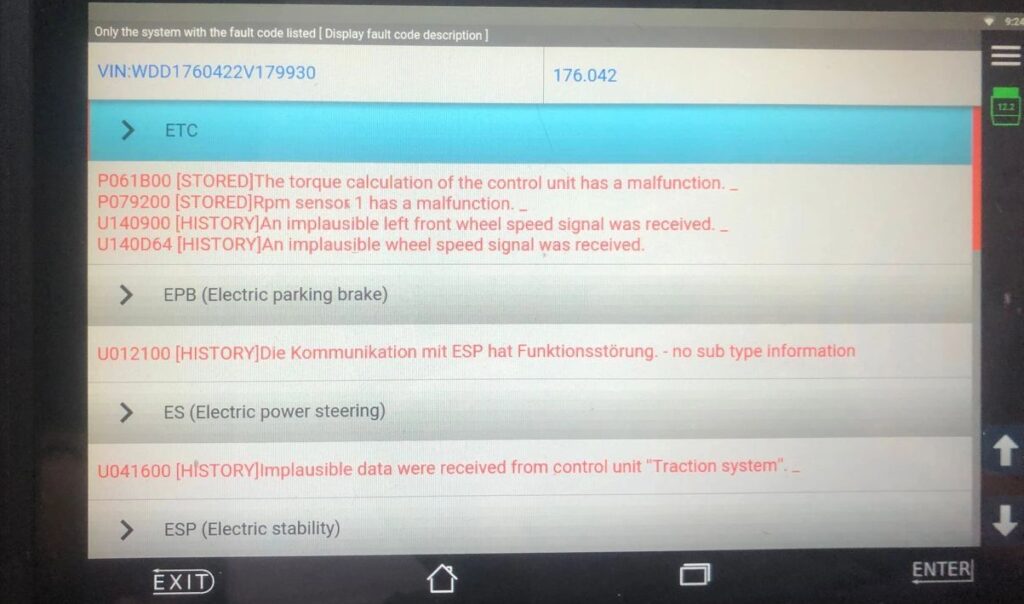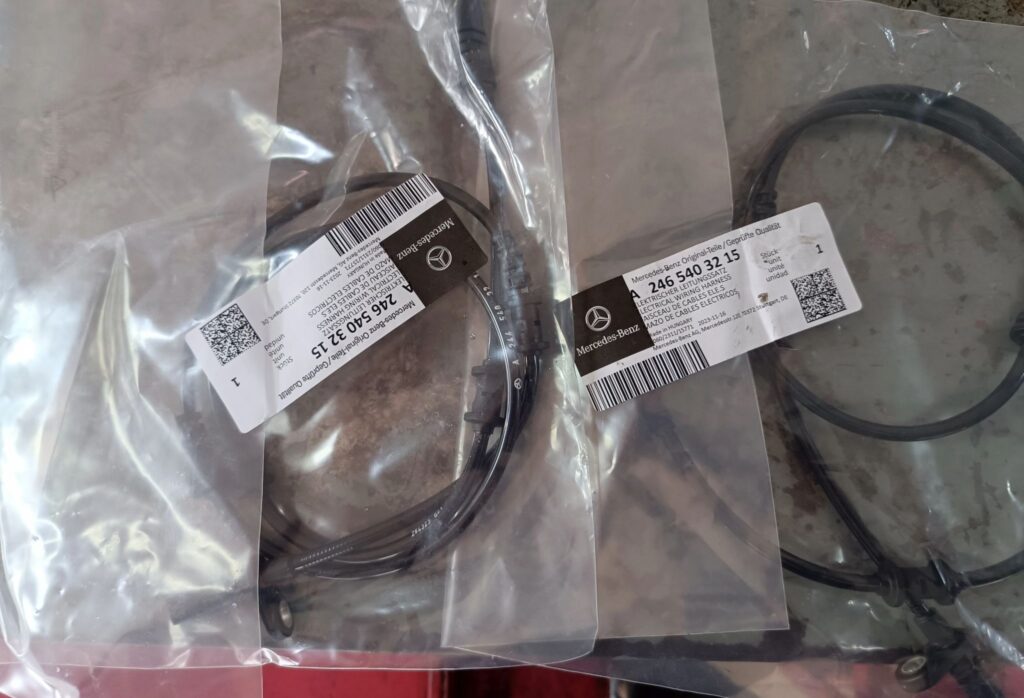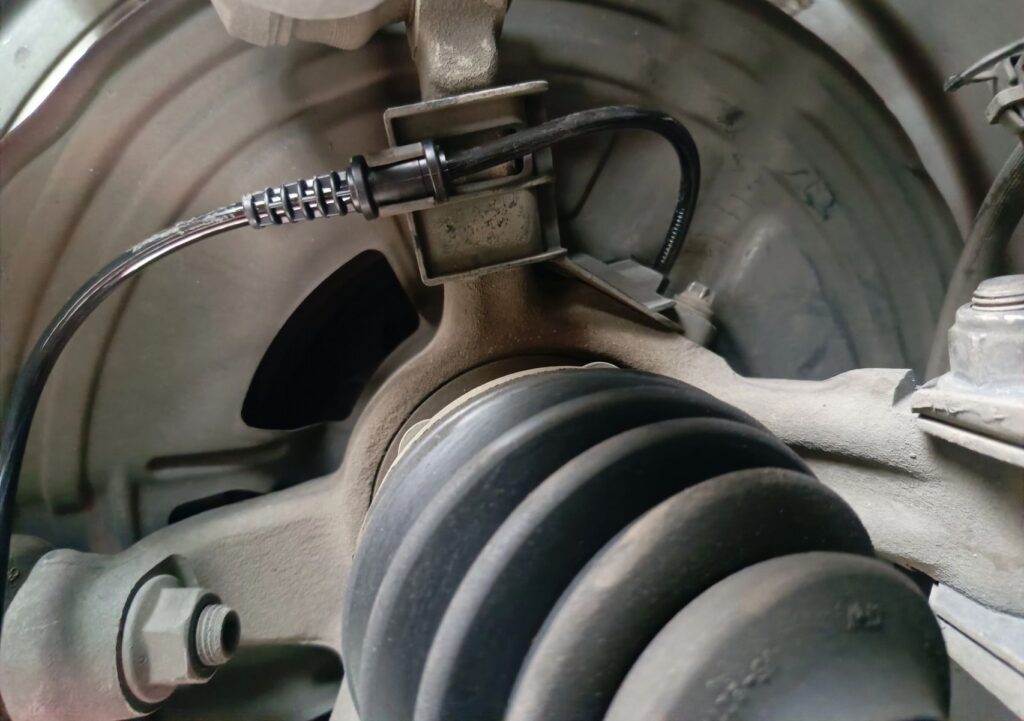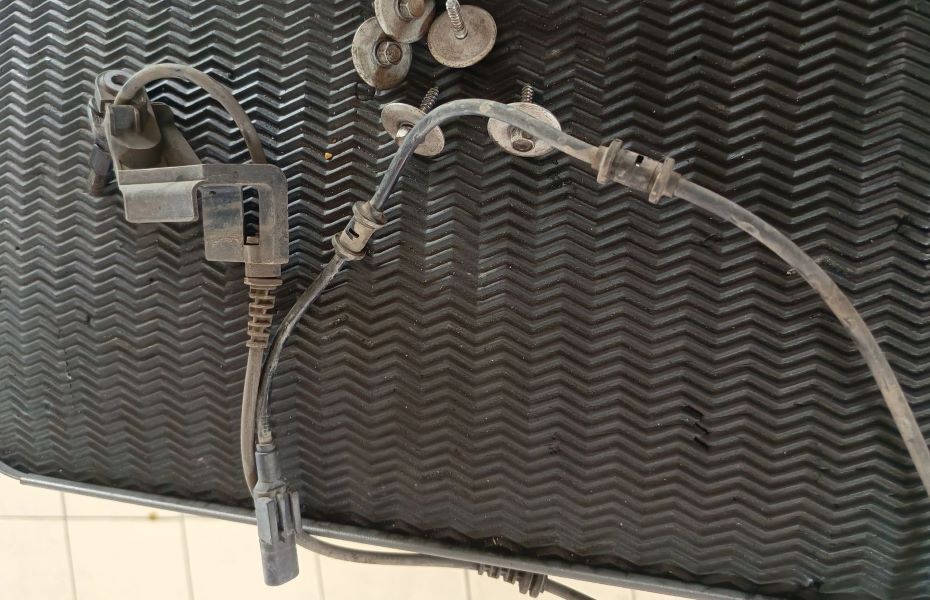Table of Contents
ABS Light On Car: Causes, Diagnosis & Fix (Case Study)
When the ABS warning light appears on your Mercedes dashboard, it signals a problem with the Anti-lock Braking System (ABS) one of your car’s most important safety features.
The ABS prevents your wheels from locking up during hard braking, maintaining steering control and stability, especially on slippery roads.
If this light stays on, it means the system is disabled, and your vehicle will rely solely on conventional brakes. While basic braking will still work, emergency stopping performance will be compromised.
This guide featuring a real case study on a Mercedes-Benz A-Class (W176) explains:
- – Why the ABS light turns on,
- – How technicians diagnose it step by step, and
- – How to fix it safely and effectively.
For a full overview of related systems like ESP and Brake Assist, visit our hub:
Mercedes Brake System Problems: ABS, ESP & Brake Assist Guide
Common Causes of the ABS Warning Light in Mercedes Vehicles
| Cause | Description |
|---|---|
| Faulty wheel speed sensor | Most common cause sensor fails to send wheel speed data to the ABS control unit. |
| Damaged wiring harness | Broken or corroded wires interrupt communication between the sensor and the control unit. |
| Low brake fluid level | Can trigger both brake and ABS warning lights simultaneously. |
| Defective ABS control module | Internal failure prevents data processing and activation of the ABS pump. |
| Corroded sensor ring (tone ring) | Debris or rust interferes with sensor readings, triggering false signals. |
Case Study: ABS Light On in a Mercedes-Benz A180 (W176)
A Mercedes-Benz A180 (W176) came into the workshop with the ABS warning light illuminated on the dashboard.
Here’s how the technician diagnosed and resolved the problem.
Step 1: Fault Memory Scan
A diagnostic scan using Scan tool revealed a fault code linked to the right front wheel speed sensor.
This sensor constantly measures the rotation speed of each wheel.
When one sensor fails, the ABS control unit detects inconsistent signals causing the ABS light to appear.

Step 2: Test Drive for Data Verification
The technician performed a test drive while monitoring live sensor data.
The affected wheel showed irregular readings compared to the others, confirming that the sensor output was inaccurate.
Diagnosis confirmed: Faulty wheel speed sensor.
Step 3: Replacing the Faulty Wheel Speed Sensor
The technician replaced the defective sensor following these steps:
- 1. Lift the vehicle safely and remove the affected wheel.
- 2. Disconnect the electrical connector and unbolt the sensor from its mounting point.
- 3. Clean the sensor seat area of dirt or corrosion.
- 4. Install the new OEM wheel speed sensor and torque bolts to specification.
- 5. Reconnect wiring securely and ensure proper routing.



Step 4: Post-Repair Verification
After installation:
- – The system was re-scanned to clear all fault codes.
- – A final test drive confirmed accurate speed readings from all wheels.
- – The ABS warning light turned off, and the system was fully operational.
Result: ABS restored to factory function, no fault codes remaining.
ABS Warning Light Diagnostic Steps (DIY & Professional)
| Step | Action | Tools Needed |
|---|---|---|
| 1 | Perform a diagnostic scan | OBD-II or XENTRY tool |
| 2 | Check live wheel speed data | Scanner with live data capability |
| 3 | Inspect wheel speed sensors | Visual inspection, multimeter |
| 4 | Check wiring and connectors | Look for corrosion or breaks |
| 5 | Replace faulty components | OEM parts recommended |
| 6 | Clear fault codes and test drive | Confirm ABS light is off |
How to Identify a Failing ABS Sensor
Typical Symptoms:
- – ABS or ESP warning lights on dashboard
- – Loss of traction control or Brake Assist features
- – ABS pulsing not engaging under heavy braking
- – Speedometer drops intermittently (in rare cases)
If these occur, perform a diagnostic scan immediately to avoid unsafe braking conditions.
Preventive Maintenance Tips
- – Keep wheel hubs clean: Dirt or rust can interfere with magnetic sensor readings.
- – Avoid power washing around wheel hubs: Moisture intrusion can damage sensors.
- – Use genuine Mercedes sensors: Aftermarket sensors can sometimes give weak or delayed signals.
- – Check brake fluid regularly: Low fluid can sometimes trigger multiple brake system warnings.
- – Perform annual diagnostic scans: Early detection prevents costly module failures.
FAQs: ABS Light On Car
Q1: Is it safe to drive with the ABS light on?
You can still drive cautiously, but your anti-lock feature won’t work. In emergencies or slippery conditions, the wheels may lock up increasing the risk of skidding.
Q2: How do I reset the ABS light in a Mercedes?
After fixing the fault (e.g., replacing the sensor), clear the stored fault codes using a diagnostic scanner. The light will not reset automatically if the issue persists.
Q3: How much does it cost to fix the ABS light?
Replacing a wheel speed sensor typically costs $150–$300, depending on labor rates and OEM part pricing.
If the ABS module is defective, repairs can exceed $1,000.
Q4: Can low brake fluid cause the ABS light to come on?
Yes. A low brake fluid level can affect ABS hydraulic pressure and trigger both ABS and Brake warning lights.
Q5: What’s the difference between ABS and ESP lights?
- – ABS light: Related to braking stability during emergency stops.
- – ESP light: Indicates issues with traction or stability control, often linked to the same sensor network.
Q6: How long do Mercedes ABS sensors last?
Typically 60,000–100,000 miles, depending on driving conditions and exposure to dirt, salt, or water.
Conclusion
This case study of a Mercedes-Benz A180 (W176) demonstrates that an ABS warning light is usually caused by a faulty wheel speed sensor but accurate diagnosis is key.
By scanning for fault codes, verifying sensor data, and replacing the defective part, the ABS system was restored to full function.
Ignoring the warning can lead to longer stopping distances and reduced stability, especially in wet or icy conditions.
If the ABS light comes on, have your system inspected immediately by a qualified technician.
For related issues such as ESP inoperative or Active Brake Assist limited, check out:
Mercedes Brake System Problems: ABS, ESP & Brake Assist Guide
Author Bio
Mercedes Expert is an automotive technical trainer and Mercedes-Benz diagnostics expert with extensive hands-on experience in XENTRY, DTS Monaco, and advanced system troubleshooting. He specializes in transforming real workshop case studies into structured learning content to help technicians, car owners, and enthusiasts understand complex vehicle systems.
Last update: October 2025






Leave a Reply